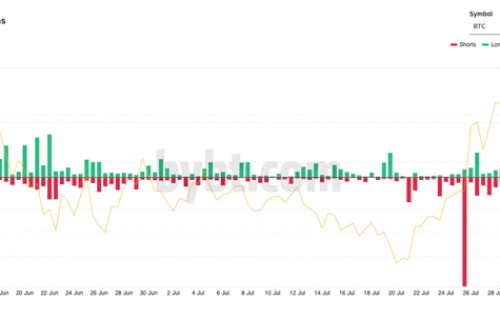VYSYN VENTURES Weekly Insights #28
As the past week has shown us, the crypto markets are still a volatile place. Speculators that tried to take advantage of the recent bullish trends were swiftly met with a correction as bitcoin retraced from $19,500 to $16,200 before staging a comeback.
These double-digit swings may be acceptable for long-term holders, but traders can quickly become liquidated by these fast moves. For this reason, a select group of crypto investors has turned to store their hard-earned tokens in high-yielding vaults.
Hitting the sweet spot between high returns and stability, DeFi vaults may be the bridge between traditional savings accounts and the high returns cryptocurrencies have to offer. In the latest VYSYN release, we highlight how DeFi speculators can maximize gains while maintaining security with DeFi vaults.
What are DeFi Vaults?
As we have written about in the past, the yield farm process can be very profitable, but it requires constant monitoring and tending. Multiple transactions are required to enter and harvest a yield farm.
Yields reinvested over time allow the principal investment to compound similarly to any other investment. However, if each transaction costs a dollar, this may discourage small-time farmers from getting involved as the cumulated fees will eat into profits.
This problem brings us to a fundamental issue – How often should one harvest and reinvest their yields to maximize profits over time while keeping fees down to a minimum? Enter DeFi vaults, the dark horse in the DeFi ecosystem.
Andre Cronje’s Yearn on the Ethereum blockchain is the most popular DeFi vault by far. The vault holds $428 million in Total Value Locked (TVL).
With a myriad of Ethereum-based vaults and emerging BSC vaults, TVL is the most critical factor in determining vault value and staying power. As crypto moves at a moment’s notice, yield farmers are always on the lookout for the next “quick flip” or other opportunities to quickly increase their capital.
While there are people very good at getting in and out of new farms, the risk of losing money or getting “rug pulled” is exceptionally high. It is a high-risk, high-reward game that leaves many rekt or down a considerable amount of tokens.
For those looking for sustainable returns over time, yield vaults have been created to automate the system. Typically these vaults are designed to handle established cryptocurrencies or those that do not fluctuate in price over time. Less price volatility means fewer returns, but there is an addressable market for this kind of risk tolerance.
DeFi Vault King Yearn
The most popular DeFi vault protocol is Yearn. The platform took the idea of centralized bank accounts and translated it over to the blockchain.
Users deposit ETH or other long-term hold coins, and the vaults automate the harvesting of DeFi returns using several popular protocols. At last check, the APY currently ranges between 1.58% and 16%.
Any well respecting financial advisor would be quite happy with a 16% return in the stock market, which is 2x the average returns. Unsatisfied with these “small” returns, developers have taken to boosting these rewards. By offering rewards in “worthless” reward tokens, users can buy said tokens speculating on future prices. If these tokens go up in price, we can see returns hit five-digit returns or higher.
Pickle Finance
One of the most popular yield farms to tackle this issue is Pickle Finance. Pickle focuses on providing incentives for users who contribute liquidity in ERC-20 stablecoins.
Instead of dealing with volatile tokens, the Pickle system is designed to dampen any price fluctuations on tokens like USDT and DAI to create a “more stable” stablecoin. By using stablecoins as liquidity, there is very little chance that investors will experience “impermanent loss” or a drop in price for their provided liquidity.
Of course, the opposite can happen. In this case, the liquidity pair increases in value while still providing reward tokens. Pickle Jars or pJars are designated vaults where users deposit their liquidity pairs, earning them automated rewards in PICKLE and ETH. But as with most successful crypto projects, bad actors moved to exploit whatever flaws they could find in the system.
One code exploit allowed a Pickle Jar to be drained of $20 million in DAI after a hacker created a duplicate Pickle Jar and siphoned off deposited funds. Seeing an opportunity to grow the space and increase their presence, Yearn quickly partnered with Pickle Finance. Not only will Yearn compensate those who were affected, but the teams are working to boost yields and inject stability into the project.
This kind of collaboration is rare but not unheard of in the cryptocurrency space. Some development teams choose to partner up out of the gate to increase their odds of surviving.
Beefy Finance
One such company is Beefy Finance, which we have written about before. Unlike established projects like Yearn, Beefy is a new yield vault built on the Binance Smart Chain (BSC).
As BSC offers faster speeds and lower fees than Ethereum, it has become a draw for smaller yield farmers and those looking to experiment. As a new project, Beefy is taking risks with other new projects in the BSC space. While this is riskier than going with established stablecoins, the rewards are also much higher.
Pancake Swap and ThugSwap (Traphouse) are two of the more established and recognizable BSC yield farms. Their tokens CAKE and DRUGS, respectively, are two of the most traded assets on BSC.
Yes, that is 150,400% and 1,990% APY, respectively. Traditional economists may look at these rates as a clear sign of hyperinflation, but as long as people invest in the projects and believe they will do well, the more people will opt-in.
Those familiar with the “greater fool theory” may see this as another bubble waiting to pop, and it may very well be. But the same could be said about Bitcoin or any of the 6,000 + cryptos. As we said before, with continual attention on these projects, there should be enough open interest to keep the prices high. Pancake has already been accepted into the Binance DeFi Accelerator program, and Thugs is expected to be shortly.
Inspired by Yearn
Taking a page out of Yearn’s playbook, Beefy Vaults automate the yield farming process across multiple protocols. Aside from the passive income benefits, these vaults offer the ability to earn rewards IN liquidity pairs.
By rewarding users with more Liquidity Tokens, Beefy is completely automating the reinvesting of returns, very similar to how a stockbroker like Vanguard will reinvest dividends. For example, by providing liquidity for BTC-BNB, a user would earn additional BTC-BNB LP tokens at a daily rate of 0.14%.
These can be left on the vaults or be taken to another BSC yield farm to earn different rewards. But as it stands now, the vaults offer a sustainable way to earn passive income over time with minimal maintenance.
Naysayers may have several objections to this, the most popular seems to be “If this is so great, why haven’t I heard of it before?” Luckily the answer is quite simple.
These vaults are on the cutting edge of yield farming and cryptocurrency, both of which require a higher level of technical knowledge. It also requires a level of risk-tolerance found mainly in professional gamblers and day-traders.
Combined with the factors mentioned above, these variables significantly limit the demographic of users. The DeFi space continues to grow at a breakneck pace. There is now $13.33 billion in TVL across the Ethereum DeFi space and nearly $150 million on BSC.
DeFi Vaults as the Intersection of Profits and Security
As Fortune 500 companies and billionaires continue to dip their toes into Bitcoin, the underlying sentiment is that BTC is here to stay. This recent bull run has quickly silenced those crying for Bitcoin to drop to $1,000 or zero.
And yet, there are still people looking to maximize gains while limiting their downside. For those looking for the intersection between profits and security, DeFi Vaults may be the path forward.


